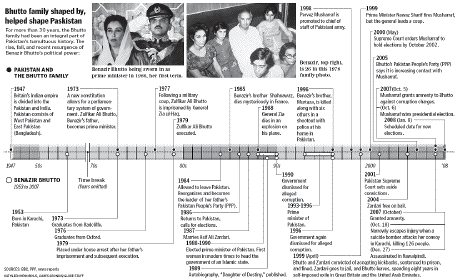Adil Najam
Benazir Bhutto, twice Prime Minister of Pakistan, now lies under six feet of earth in Garhi Khuda Bux, her ancestral village, in a grave next to her equally mercurial father, the late Prime Minister Zulfiqar Ali Bhutto.
As the graphic above (click to enlarge) from Boston Globe shows, hers – like her father’s – was a brilliant but tragic life. Tragically ended.
Now she is buried. But I suspect that the Benazir saga is far from over. Indeed, just as all of Pakistan’s politics after Zulfiqar Ali Bhutto’s hanging was contextualized by his hanging, all of Pakistan’s politics after Benazir’s assasination is likely to be contextualized by Benazir’s assasination.
In the immediate aftermath of this tragic death, the country continues to reel in grief at what has happened, fear about what might happened, and immense immense anger and everything that has been happening. As I argued in an op-ed in the New York Daily News today, this mix of grief, anger and fear is a very dangerous combination. It cannot lead to any good.
Right now the scenes we see on our screens are of mayhem, of devastation, of further violence, of destruction. These are not good images for Pakistan and certainly these are not the Benazir Bhutto would have wanted as her legacy. We at ATP have written many many times about the climate of anger that defines modern Pakistan (here here, here, here, here, etc.). This anger is the single most disturbing and single most defining motif of today’s Pakistan. Right now – and not without reason – the anger is being directed at Gen. Pervaiz Musharraf’s government. Much of this should, but not in this way.
More important to note is who the anger is not being directed at. I hope that the legacy of Benazir Bhutto’s untimely and tragic death is a legacy of a society that seizes this moment to reassert its demand for democracy and to recognize that extremist violence is our problem. This is not a mercenary war. This is Pakistan’s own battle. Right now the evidence suggests that society continues to tear at its own self. I fear that it will not change anytime soon. That things are likely to get worse before they become any better. But, I refuse to give up hope. At least, not yet.
As I wrote in my New York Daily News op-ed:
If this moment ends up being defined by Pakistan’s latent anger – if it launches a cycle of crackdowns and protests – it will certainly empower and embolden the militants further. But if it is defined by society’s sense of shared loss, felt grief and the continued movement toward genuine democracy, it might – just might – bring together a fractured society and awaken in them the realization that the common enemies are extremism, violence and terrorism. Then, we might just have half a chance of winning this war on terror. And Benazir Bhutto’s death would not have been in vain.




















































It seems very odd to me that there was no representation from this administeration or other political parties at the funeral.
How are we goimg to start process of healing?
“The future has not been written. There is no fate but what we make for ourselves. I wish I could believe that”
This question of our future maybe properly addressed by our Army/ISI and White House/CIA, as we Pakistanis don’t matter in future of Pakistan.
Rahim Khan we need to calm people with facts. All these things has happened under every ruler since the birth of Pakistan but extremism is new. Its better we go after the real threat to Pakistan and its not Mushraf its Extremism and these evils need to be condemned .
The looting, rioting is not being carried out by PPP workers but people who are taking advantage of the situation, as AAJ TV and others have reported.
“Unifying” leaders are not born overnight. The main focus right now should be to pacify the province of Sindh. Their perspective is that the Punjabi military has crushed and brutally murdered ALL of their leaders: Zulfiqar, Murtaza, and finally Benazir. These leaders were not like the lotas and Chaudhrys of Punjab who are a dime a dozen; these were national leaders. As someone who is from Sindh, I can tell you that the reverence for Bhuttos is so intense that even us (the “educated” Sindhis) often talk about how this devotion is sometimes irrational.
The very core of this blog, i.e. Pakistaniat itself is in an extremely fragile state: the Balochis feel disenfranchised because of their economic state and because of the murders of Bugti, etc; the NWFP feels like the military is out to kill them on the orders of Uncle Sam, and finally, Sindh, who has had its resources quenched and its politics hijacked by the MQM, has its last hope murdered.
If Pakistan’s despots (i.e. Busharraf) have any concern for PAKISTANIAT, they will look to pacify the other provinces. As Talat Hussain and others have mentioned, this is the time when symbolic gestures can go a long way: there were so many calls from this blog’s readers to commemorate Bob Woolmer by naming a stadium after him; what will Pakistan do to honor a woman who gave her life for the cowardly men who could do nothing to protect her?
Among other things, I think her death is a serious, serious blow to women’s rights movement in Pakistan. Despite her faults, her leadership was undeniable testament to what is possible. Where else are we going to find a Pakistani woman around whom every chaudhrys and wadera was extremely self-conscious?
So many people dying on mush’s watch, Bugti, Bhutto, thousands of our innocent citizens, while media is shut, judges are under house arrest.
Where else blame may be placed?
How long he is going to hide behind army and Aiwan-e-Sadr?